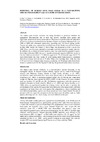Please use this identifier to cite or link to this item:
https://accedacris.ulpgc.es/jspui/handle/10553/107121
| Title: | Potential of almako jack Seriola rivoliana as a fast-growing species for European aquaculture diversification | Authors: | Roo, J. Grossa, E. Lenoir Schuchardt,Dominique Socorro, J. Hernández-Cruz, C. M. Izquierdo, M. S. Fernández-Palacios, H. |
UNESCO Clasification: | 310502 Piscicultura | Issue Date: | 2010 | Conference: | Aquaculture Europe 2010 | Abstract: | The almaco jack Seriola rivoliana has being identified as potential candidate for aquaculture diversification due to their fast growth, excellent flesh quality and significant international market opportunities. The present work describes the adaptation of Seriola rivoliana broodstock in the Instituto Canario de Ciencias Marinas from year 2006 to 2009 and subsequent maturation, spawning and first larval rearing results. Twenty sub adults were captured by local fisherman in the South coast of Gran Canaria in May 2006. Initial fish weight (1.76± 0.25kg), was increased to 6.0± 1.1kg in July 2009. Every year fish were sampled to determine individual growth in weight and size. In addition, the evolution of sexual maturity state was established by gonadal biopsies. From July to October 2009, the use of repetitive hormonal injection (LHRHa) results in ten successful spawns (total 2.75 Millions eggs) with 72% of buoyant eggs and 92.5% mean fertilization rate. First results of larval rearing under Semi-intensive conditions showed an average survival rate 2.5% after 30day after hatching (dah) while less than 0.3% survival was obtained under intensive conditions. At 90 dah juveniles from Semi-intensive systems reach 26.7± 4.7g and 14.2±5.2g fish produced under intensive system. | URI: | https://accedacris.ulpgc.es/handle/10553/107121 | DOI: | 10.13140/2.1.3260.1609 |
| Appears in Collections: | Actas de congresos |
Page view(s)
157
checked on Nov 30, 2024
Download(s)
87
checked on Nov 30, 2024
Google ScholarTM
Check
Altmetric
Share
Export metadata
Items in accedaCRIS are protected by copyright, with all rights reserved, unless otherwise indicated.
